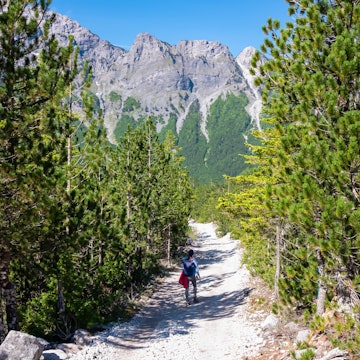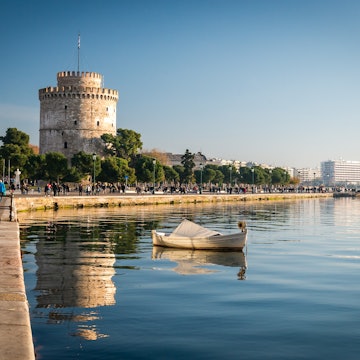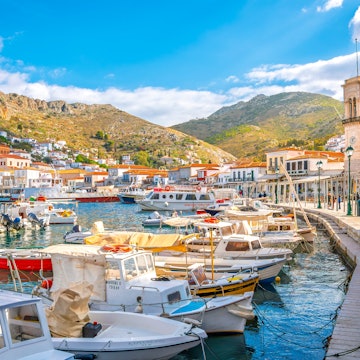

The fabled date palms at Vaï Beach, Crete, Greece. Lukasz Tyczkowski/Shutterstock
The fabled island province of Crete has some of the most scenic, best situated beaches in all of Greece. And since many are far from developed areas, you might just have them all to yourself.
Although almost every main beach gets busy in July and August, a patch of sandy heaven with fewer crowds usually just lies a short walk away. With a few notable exceptions, the water at Crete’s beaches is usually calm, good for swimming and water sports.
These are our favorite eight beaches in Crete.

1. Elafonisi Beach
Best beach for colorful sand
Sparkling white sand with a pinkish hue makes Elafonisi a standout in a nation where pebbly, grey beaches are common. Shallow, azure waters surround an islet just offshore that is an easy walk.
Cliffs, dunes and semi-secluded coves are the highlights here. In summer, there’s no shortage of refreshments, and you’ll find umbrella, lounge and gear rentals on the main beach.
You can beat the summer crowds by walking 1km (½ mile) along the coastal trail east to Kedrodasos Beach. Otherwise, climb the dunes on the islet for panoramic views of this entire magical spot. Venture further afield for more solitude, or come in the off-season, when the water dazzles with myriad points of light and the only sounds are the wind and waves.
Planning tip: The swath of Elafonisi closest to the parking areas is by far the most crowded. Cross the narrow, pink isthmus of sand to the nearby islet, where you’ll enjoy open sand and wide-open views.

2. Balos Beach
Best beach for a castle adventure
The drive alone to the beaches at Balos dazzles, with the remote Gramvousa Peninsula on the far northwest tip of Crete boasting cliffside views and wild, rocky terrain.
Lagoons surround the main beach, their shallow waters brimming with tiny, darting fish and cagy shellfish. There are two easily reached islets right offshore, via a walk through the placid waters: Agria (which means “wild”) and Imeri (“tame”). The latter includes the ruins of a 16th-century Venetian castle that has great views across the beaches and lagoons. Services here are few beyond umbrella and lounger rentals.
Getting to Balos is a marvelous adventure. By road, you need 4WD to navigate the 12km (7½-mile) dirt track from the village of Kalyviani. From a tiny parking lot with a snack stand, it’s a 1¼km (¾-mile) hike down the sandy cliffs to the beach. An even better option is the day-trip boat from Kissamos, which includes a few scenic stops along the peninsula. Even in summer, there are few people at Balos before 11am and after 4pm.
3. Paleohora Beach
Best beaches for food, drinks and fun
The liveliest town on the southwest coast boasts two beaches, each with a name that tells you all you need to know about its character: Pahia Ammos Beach (Sandy Beach) and Halikia Beach (Pebble Beach).
But don’t expect a Mykonos-like scene here, for Paleohora still retains a village feel, its narrow, stone lanes meandering past cafes, tavernas and bars where you can enjoy live Cretan music. Services abound, and families can rent gear for relaxing days on the sand. The sports-minded can windsurf off Pahia Ammos, which also has fun beach bars. Halikia hosts great tavernas and even a few bars and clubs.
Few can resist the pull of the commanding Venetian castle, which dates to the 13th century. Don’t expect a fortress, however, as centuries of battles have rendered it more ruin than redoubt.
Paleohora is worth a visit year-round and is easily reached by bus from Hania.
Detour: Hikers will find coastal trails leading to even quieter beaches such as Gialiskari, as well as various historic and archeological sites.

4. Falasarna Beach
Best beach for surfing
Sunsets dazzle throughout the year at the long beach in Falasarna, which faces directly west. Waves here are regularly the largest in Crete – and draw people ready to ride them, whether on a board or freestyle – with sets of rollers crashing into the sand from the open Mediterranean.
The sand here has the same pinkish-white hue that makes Elafonisi, to the south, so famous. Tavernas, cafes, modest hotels and gear-rental stands line the shore in summer. Olive trees and greenhouses form a backdrop to the beach scene.
Like most beaches in Crete, Falasarna gets busy in summer, though as elsewhere more-isolated and quiet sandy coves are found north of the long, main beach.
Buses here are summer-only. Yet since it lacks a year-round village, Falasarna is a lovely and lonely escape in winter, if you have a car.
Detour: An easy 2km (1¼ -mile) walk along a dirt path takes you to the site of Ancient Falasarna, which dates to the 4th century BCE. Stones mark out where walls protected the old port of this once-thriving city-state.
5. Vaï Beach
Best beach for subtropical magic
Try to catch falling dates from the largest natural palm forest in Europe at Vaï, on the northeast end of Crete. Botanists think that these trees are a subspecies unique to the island; visitors just think they’re magnificent. They offer a bit of lush tropical appeal on an island better known for its sun-drenched, semi-arid expanses.
The beach at Vaï is small but perfectly framed by turquoise waters lapping at the edges of the inlet. It’s a gorgeous setting and one worth exploring beyond the main beach: trails lead to cliffside walks, vista points and more-secluded, clothing-optional coves.
Planning tip: From May to October, regular buses reach Vaï from Sitia, 24km (15 miles) to the west. Ride these to avoid the hassle of the traffic-clogged access road to the parking area.

6. Preveli Beach
Best beach for swimming
At the end of a gorge on the south coast of central Crete, the beach at Preveli is a legend on the island. The river Megalopotamos flows into the sea here, which allows visitors to wander the riverbanks taking dips in freshwater pools shaded by palm trees. It’s simply sublime.
The main beach area has the usual umbrella and snack vendors. It’s a steep walk down from the car park, but once on the sand, it’s worth walking a bit more as the furthest reaches are some of the sandiest and most appealing. Since there’s no permanent village, the entire area is nearly devoid of people in the off season.
Few people visit Preveli without also stopping at Moni Preveli, an ancient monastery that sits high on a promontory looking across the Libyan Sea; its chapel is a spectacle of glittery artwork and gilded artifacts. A museum covers the many struggles for Cretan independence that were centered here.

7. Xerokambos Beach
Best beach for a getaway
Views that almost seem to stretch to Africa are but one of the appeals of this swath of sand in the far southeast corner of Crete. With wide vistas of the Mediterranean as you descend the curving mountain road, the drive down to this beach is almost as spectacular as the destination itself.
Travelers who venture to this corner of the island leave most other visitors far behind; still, you’ll find relaxed holiday rentals and a few excellent tavernas. In addition to Xerokambos, more beaches with even fewer people lie along this coast, making it an ideal escape from the resorts elsewhere on Crete.
Detour: Just north of Xerokambos is the archaeological site in Zakros, once a major Minoan palace. Though it doesn’t have the cachet of Knossos near Iraklio, it does offer secluded and atmospheric wandering.

8. Matala Beach
Best beach for your inner hippie
Almost in the middle of Crete’s south coast and nearly the southernmost point in Europe, Matala is a beach town with a load of lore. Set on a protected bay and boasting one of the island’s best patches of powdery sand, Matala gained fame in the late 1960s as a haven for hippies, who were lured by rent-free living (you might call it squatting) in the caves that pockmark the sandstone cliffs bracketing the beach. Among them was singer-songwriter Joni Mitchell, who immortalized the scene in her 1971 song “Carey.”
The scene lasted for several years as the area became a counterculture haven, a reputation it has never tried to shake off. Today, it’s primarily a family-friendly place with a tie-dyed vibe. While it’s become hugely popular in summer, you can still catch some of the legendary feel-good ethos – especially during its legendary sunsets – during the less-crowded shoulder months, April to June and September through October.
















